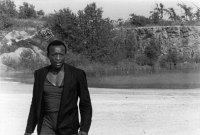The relationship Walker has enjoyed with Jones is a rich one, starting with a summer residency in 1981 where he premiered Break, an outdoor duo work (performed with local dancer Maria Cheng) on Nicollet Island. He has returned, usually with his full company, eleven more times from 1983-2005, developing community-based productions, researching and mounting new solo and large-scale company works, hosting community discussions, curating exhibitions, performing in schools, teaching masterclasses, and becoming a much admired part of this community.
The relationship Walker has enjoyed with Jones is a rich one, starting with a summer residency in 1981 where he premiered
Break, an outdoor duo work (performed with local dancer Maria Cheng) on Nicollet Island. He has returned, usually with his full company, eleven more times from 1983-2005, developing community-based productions, researching and mounting new solo and large-scale company works, hosting community discussions, curating exhibitions, performing in schools, teaching masterclasses, and becoming a much admired part of this community.
Media
Biographical Information
American, b. 1952A courageous, at times conflicted, choreographer, Bill T. Jones has deftly balanced social/political concerns with abstract work of formal beauty and complexity. Together with partner Arnie Zane, he helped introduce elements now common in contemporary dance: partnering between men; the casting of...
American, b. 1952A courageous, at times conflicted, choreographer, Bill T. Jones has deftly balanced social/political concerns with abstract work of formal beauty and complexity. Together with partner Arnie Zane, he helped introduce elements now common in contemporary dance: partnering between men; the casting of dancers of all shapes, sizes, and colors; involvement of entire communities (professional performers and amateurs alike) in the creation of key works; use of spoken text and movement simultaneously; an exploration of autobiographical truths in his work (presaging much of the identity politics of the 80s and 90s); and the use of a full amalgam of movement styles and collaborative strategies.
The struggle between the literal and the abstract, the political and the formal, the angry and the cool, have always fed Jones’s work. The son of migrant Southern Baptist farm workers, Jones and Zane began unorthodox explorations of contact improvisation and personal revelation soon after they met in 1971. Rejecting the austere prescriptions of the Judson Dance innovators of the time, they embraced narrative, pop music, fashion, sets, costumes, and full theatricality.
Jones has spent a life confronting the issues that he has often said “unite us outside of the aesthetic”—the cultural and historical struggles that continue to define the country and its people. In recent decades, he and the Walker have grown up together. His often painful struggle balancing what he feels are the responsibilities of an engaged citizen with the pure commitment to his art have only served to make his work richer, more emotionally engaged, and increasingly profound. He is an artist and public figure who gives one hope in sometimes hopeless-feeling times.


